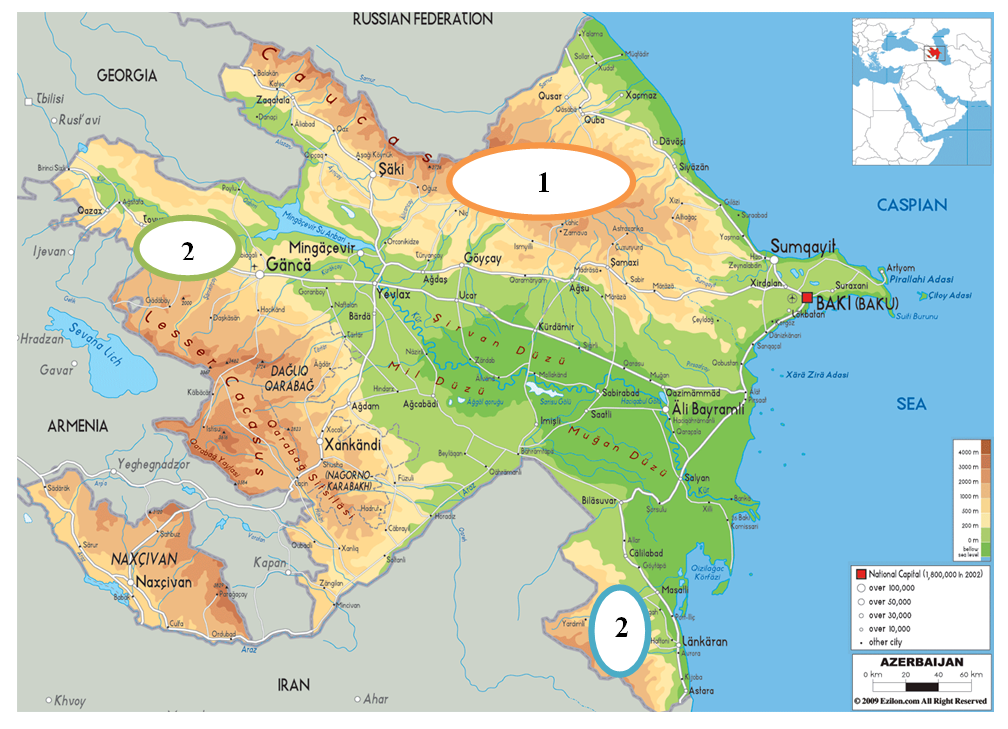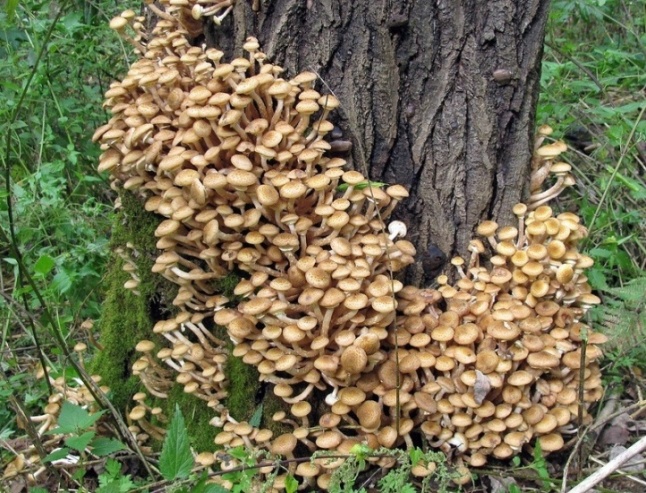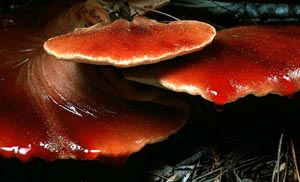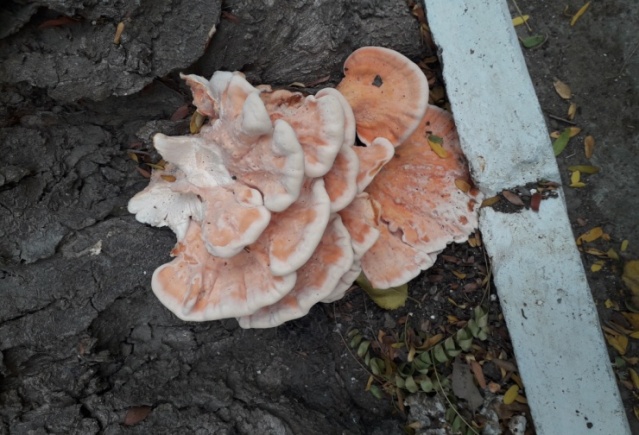Besti N. Alıyeva
Institute of Microbiology of the NAS of Azerbaijan, Baku
Correspondence to: Besti N. Alıyeva, Institute of Microbiology of the NAS of Azerbaijan, Baku.
| Email: |  |
Copyright © 2019 The Author(s). Published by Scientific & Academic Publishing.
This work is licensed under the Creative Commons Attribution International License (CC BY).
http://creativecommons.org/licenses/by/4.0/

Abstract
In the presented work, edible species of xylotrophic macromycetes spread in Azerbaijan were investigated by the species composition, frequency of occurrence, and by the amount of fruit produced in nature. The results showed that in Azerbaijan 9 species of edible xylotrophic macromycetes are common. During sampling was used from the method of the route and from the result of analysis of samples taken became clear that in Azerbaijan The frequency of occurrence of mushroom species with a one year life is between 0.000021-0.76 units/ha. According to the mathematical calculations were determined that the minimum amount of fruit body produced by mushrooms recorded in studies in Azerbaijan during the year varies between 0,0025 -98,8 t(approximately 217 t).
Keywords:
Xylotrophic macromycetes, Edible species, Frequency of occurrence, Fruit body, Resource potential
Cite this paper: Besti N. Alıyeva, Species Composition and Resource Potential of Edible Xylotrophic Macromycetes Spread in Azerbaijan, Advances in Life Sciences, Vol. 9 No. 2, 2019, pp. 15-19. doi: 10.5923/j.als.20190902.01.
1. Introduction
Increasing anthropogenic impacts on the environment also worsen the environmental situation. Thus, the relationship between plants, animals, fungi and other biodiversity determines the state of the ecosystem, and any factor that causes them to change, at the same time, causes a change in the ecosystem as a whole [Flandroy L. et al. 2018]. These changes are often characterized by a negative side that one of their manifestation forms is the observation of various pathologies in human health. As a result of these pathologies increase cardiovascular and oncological diseases, weakening the immune system [Kelishadi R., 2012]. Preventing these is also one of the most urgent research areas of the modern era. The main focus of conducted studies is obtaining antibacterial, antivirus, antifungal and anti-tumor functional products and their use from natural sources is important. In this regard, one of the main directions of modern mycology and biotechnology is to identify the possibility using of fungi, including edible species of basidiomycetes belonging to the xylotrophs.İn modern time, xylotroph macromycetes is on the spotlight as producers of many biologically active substances, including proteins, enzymes, lipids, polysaccharides, polyacetylene, organic acids, vitamins and so on [Bahshaliyeva K.F. et al., 2019, Riikka Linnakoski et al., 2018]. and even in some countries, the production process was carried out in their example. These substances are biologically and pharmacologically active than obtained by chemical synthesis, have a less toxic impact and their use does not cause side effects. So far, more than 3,000 substances have been obtained from fungi, including antibiotics, anti-inflammatory, immuno-modulating, hypolipidemic, hepatoprotective, antihelmint, lipotensitive, insecticidal, thrombosis and diabetes. Thus, antibiotics and other medicinal preparations obtained from fungi In addition to stimulating the immune system in the human body, they also have antibacterial, antifungal and anti-AIDS effects [Adotey G. Et al., 2011, Winnie Chemutai Sum et al., 2019]. Considering that medicinal preparations obtained from fungi do not have any negative effects on the organism, as well as economically cheaper and more affordable raw materials than plants and animal sources, then it will become clear how much research in this area is relevant. At the same time, the lack of literature data about of basidiomycetes spread in our country and biologically active substances synthesized by them proves the importance of solving this problem. Although it is not possible to give a specific figure about species of xylotroph macromycetes, there is no doubt that this number is over 1,000 and the number of species spread in Azerbaijan is 212 [Akhundova N.A. et al., 2019]. A small proportion of xylotroph macromycetes, both in the world and in Azerbaijan, have been involved in research as producers of biologically active substances. One of the interesting results in these studies is the difference of quantitative indicators of the biosynthetic ability of xylotrophic mactomycete distributed in one or the other biotope. For this reason, the fungal strain isolated from a specific biotope will likely be more productive and the urgency of the research conducted in this area remains in full force.Therefore, the purpose of the presented work was dedicated to the investigation of edible species of xylotrophic macromycetes spread in ecologically diverse areas of Azerbaijan by the species composition, frequency of occurrence, and the amount of fruit body produced in the natural environment.
2. Material and Method
The studies were carried out in plain and mountain forests of the Azerbaijan Republic, which are ecologically distinct and locates in large geomorphological units such as the Greater Caucasus, the Lesser Caucasus and the Talysh Mountains (fig. 1). During sampling was used method of routing and primary passportization of collected samples, in other words, passportization of fruit body of one or another species of mushroom was carried out on the spot. In the course of the research were taken more than 500 samples. Samples were taken either in the beginning of summer (June) and in autumn (September). Identification of mushroom was carried based on the morphological description of the fruit body and microscopic data (a form of basidi and basidiospore, size, specific structural elements, etc) and this time has also been used from know determinants [Bernicchia A., 2005]. | Figure 1. An overview of the surveyed areas. 1—Greater Caucasus; 2-Small Caucasus and 3- Talish Mountains |
Frequency of occurrence (P) of mushroom was calculated according to the following formula:P(unit/ha)= N/SHere N is a number(units) of recorded fruit body belongs to the concrete species collected along of the selected route, S- is the area of the selected route (ha). In order to find the area of the route was used the size of width (a) and length (b) expressed in -m: S=ab. To determine the amount of fruit body formed by mushroom in the natural environment were used from the following mathematical calculationsM = [(X1+X2+.....+Xn)/n]x(SP)Here- M is the weight of the fruit body produced by the mushroom in natural conditions (t), X1 X2, Xn is the weight of the taken fruit (kg), n is the number of fruit bodies (n), S is the total area of the studied forest (ha), P is the frequency of occurrence the fruit bodies. Experiments carried out in research were conducted at least 4 repetitions and the results obtained were statistically processed [Sukhatme P. V., Pans V. G., 1995].
3. The Results and Discussion
From the result of the analysis of samples collected from different forests of Azerbaijan in 2015-2019 was determined that 53 species of xylotrophic basidiomycetes distributed in these areas. Of the registered species, only 10 belong to the category of edible mushrooms. Their names and signs taken into consideration during identification are given below: 1. Armillaria mellea (Vahl) P. Kumm., Der Führer in die Pilzkunde: 134 (1871) [MB#190066].The mushroom found in the all studied area. FB(fruit body) of mushroom is observed in the early summer and among of substrates in which they are located takes part both alive and dead plants. Although it is more common in the broad-leaved trees, it is also common in the coniferous trees. During the year formation of FB occurs with two waves and is located as a group. The number of FB-s in the group is 10-20, some times more (fig. 2). | Figure 2. Numerous fruiting bodies of the fungus Armillaria mellea |
Although it is not characterized by a high frequency of occurrence among recorded fungi (0.25 unit/ ha), but its resource potential in the natural condition of Azerbaijan is sufficient. and the average weight of MC in different groups varies between 75-520 g (average 285) g. Considering that the total area of natural forests of Azerbaijan is 1 million hectares, then it is possible to note that the amount of FB produced by fungi in Azerbaijan twice a year is about 14.25 t. 2. Fistulina hepatica (Schaeff.) With., A botanical arrangement of British plants 3: 405 (1792) [MB#193923].In the course of the research, the mushroom was found only in the forests located in the Talysh Mountains (fig. 3). The frequency of occurrence was contained 0.000021 units/ ha. This also allows us to note that the mushroom is one of the rare species found in Azerbaijan. In our opinion, this mushroom should also be regarded as an object of the Red Book.  | Figure 3. General view of the fruit body of the fungus Fistulina hepatica |
FB of mushroom which is formed in natural conditions is one-year-old and mainly observed once a year in August-September. Its annual FB amount in the forests of Azerbaijan can be approximately 0.0025 kg.3. Ganoderma lucidum (Curtis) P. Karst., Revue Mycologique Toulouse 3 (9): 17 (1881) [MB#148413].They have uneven distribution throughout the studied forests of Azerbaijan, as they are characterized by a higher frequency of occurrence in the Greater Caucasus. In general, the frequency of the occurrence of mushroom activity is 0.12 unit/ ha. FB- is one year old and the wave of its forms throughout the year occurs 1 time (fig. 4). | Figure 4. General view of the fruit body of the fungus Ganoderma lucidum |
As to the resource potential, the amount of FB produced by mushrooms in Azerbaijan during the year is approximate 0.09 t. 4. Kuehnerómyces mutábilis (Schaeff.) Singer & A.H. Sm., Mycologia 38: 505 (1946) [MB#287387].Mushroom is not considered to be the most common species in Azerbaijan and its frequency of occurrence is 0.0012 h / ha. The formed FB is located in a group and each group may have 5-12 sometimes 20 FB. It is generally found in summer and the wave of FB occurs ones a year.The amount of FB produced by mushrooms in Azerbaijan during the year can be approximately 0.19 t.5. Laetiporus sulphureus (Bull.) Murrill, Mycologia 12 (1): 11 (1920) [MB#299348].During the research, the mushroom was found in the Big (fig. 5) and Small Caucasus, as well as in the Talish Mountains. Mushroom produces FB twice a year (May-June and September) but it stays in a short time. The reason for this due to the fact that the FB of mushroom is extremely sensitive to temperature and is eaten by insects for a short period.  | Figure 5. General view of the fruiting body of the fungus Laetiporus sulphureus on in Gleditsia caspica Desf |
The frequency of occurrence of mushroom contains 0.78 unit/ha, which in the studied forests the amount of produced FB (if twice formed) per year contains 90.0 t. 6. Panus tigrinus (Bull.) Singer, Lilloa 22: 275 (1951) [MB#302220].The spread of mushroom has been found in all the forests studied and its frequency of occurrence was 0.12 unit/ ha. The fact that the FB produced by the mushroom has a relatively small weight (42g on average) is due to its low resource potential. Thus, the amount of FB that form in the forests of Azerbaijan during the year can reach to 5.0 tons. 7. Pleurotus ostreatus (Jacq.) P. Kumm., Der Führer in die Pilzkunde: 105 (1871) [MB#174220].In the course of the study among the mushroom recorded it is characterized by the highest frequency of occurrence (0.76 unit/ha). In terms of ecology- trophic relationships, this mushroom which belongs to the politrophs, has a broad substrate list, that it is eutrophic. The FB that it produced is one year old and the formation of FB in the natural condition occurs in 2 waves. FB located individually and as a group and weighs 65 g on average. This allows us to note that the amount of FB produced by mushrooms in Azerbaijan during the year is approximately 98.8 t. 8. Polyporus squamosus (Huds.) Fr., Systema Mycologicum 1: 343 (1821) [MB#186284].Among studied mushrooms, this mushroom is also characterized by a relatively high frequency of occurrence (0,12 unit/ha), and spreading substrates covers all of the major forest forming species of Azerbaijan. The formed FB located individually and as a group and their average weight is 68 g. This allows us to note that the amount of FB produced by mushrooms in Azerbaijan forests during the year contains 8.2 tons. 9. Polýporus umbellátus (Pers.) Fr., Systema Mycologicum 1: 354 (1821) [MB#240963]This mushroom characterized by the relatively low frequency of occurrence (0.0017) among the species recorded in the studies. The average weight of formed FB contains 54g and the formation of FB in the condition of Azerbaijan occurs in 1 wave. This also allows us to note that this mushroom during the year is formed approximately 0.09 t of FB. As seen, from the carried out of research became clear that 9 species of xylotroph macromycetes in the condition of Azerbaijan belong to the category of edible mushroom. Although various studies have revealed the distribution of these mushrooms in Azerbaijan, they also differ both in their frequency of occurrence and the potential of bioresources in natural conditions. Thus, the frequency of occurrence of mushroom varies between 0.000021-0.76 unit/ ha and the amount of biomass produced during the year is between 0.0025 and 98.8 t. Although all of FB they are produced is one year old, they differ according to the number of waves of their formation.It should be noted that the gradual increase of the population of the Earth and the occurrence of this process within a stable territory have caused several problems since the middle of the last century. Among them those related to the meeting the global population needs for food, today are in the spotlight. Thus, the population of the Earth is projected [John Cleland, 2013] to reach 9.7 billion by 2050 which will lead to problems such as food shortages. Because even today millions of people around the world are suffering from a shortage of food. All of this also necessitates solving of the problem, such as food shortages at the expense of more unconventional sources. In this regard, mushroom one of the organisms that are in the interest. As seen from the results obtained, 9 species of registered mushroom can produce about 217 tons of FB in natural conditions throughout the year. While this is not a large enough amount, there are ways to increase this may also play an important role in the solving of food shortage problems in the world. Thus, only 1 species of registered mushroom (P.ostreatus) is cultivated extensively in the world, including in Azerbaijan. İn the cultivation of another species (G.lusidum) is currently used the extensive method. Other species are now characterized by a reserve that forms only in natural conditions. This can be considered promising in future research to find more intensive methods of cultivation of other species, implementation of the solution of the problem, such as food shortages. On the other side, many of the recorded fungi are medically important and they contain a sufficient number of components with different biological, including pharmacological activity [Muthukumaran Jayachandran, Jianbo Xiao, Baojun Xu, 2017]. More precisely, products obtained from this type of source can have both nutritional and medical value. On the other side, these products due to the protein, fat, and carbohydrate compounds, etc. have a balanced composition [Michelle M. et al., 2019]. All of this makes possible to note that the uses of mushroom are more promising and affordable. Thus, from the carried out of research became clear that in the natural forests of Azerbaijan spread 9 types of xylotrophic macromycetes belonging to the category of edible fungi that can produce about 217 tons of FB throughout the year. Although this amount small, but this can be an important approach both to increase this amount in the future and the overcoming the food shortages that are already felt in the world.
References
| [1] | Adotey G., Quarcoo A, Holliday J.C., Fofie S., Saaka B. (2011). Effect of an immunomodulating and antiviral agent of medicinal mushrooms (immune assist 24/7) on CD4+ T-lymphocyte counts of HIV-infected patients. Int J Med Mushrooms. ; 13(2):109-13. |
| [2] | Akhundova N.A., Orucova S.B., Bahshaliyeva K.F., Muradov P.Z. and Rahimov E.A. (2019) Evaluation by the Oxidase Activity of Xylotropic Macromycetes Causing White Decay. Advances in Bioscience and Biotechnology, 10:179-187. https://doi.org/10.4236/abb.2019.107013. |
| [3] | Bahshaliyeva K.F., Namazov N.R., Hasanova A.R., Garayeva S.C. and Nagiyeva S.E. (2019) Synthesis of Polyacethylenes and Polysaccharides by Mushroom Ganoderma Lucidum (Curtis) P. Karst and Pleurotus Ostreatus (Jacq.) P. Kumm. Advances in Bioscience and Biotechnology, 10:226-232. https://doi.org/10.4236/abb.2019.10801. |
| [4] | Bernicchia A. (2005) Polyporaceae s. Fungi Europaei, 10: 808. |
| [5] | Flandroy L., Poutahidis T., Berg G., Clarke G., Dao M.C. et al. (2018). The impact of human activities and lifestyles on the interlinked microbiota and health of humans and of ecosystems. Sci Total Environ., 15,627:1018-1038. DOI: 10.1016/j.scitotenv.2018.01.288. |
| [6] | John Cleland (2013). World Population Growth; Past, Present, and Future. Environmental and Resource Economics 55(4): 543-554. DOI: 10.1007/s10640-013-9675-6. |
| [7] | Kelishadi R. (2012). Environmental Pollution: Health Effects and Operational Implications for Pollutants Removal. Journal of Environmental and Public Health. Volume 2012, Article ID 341637, 2 pages. http://dx.doi.org/10.1155/2012/341637. |
| [8] | Michelle M. Martínez-Montemayor, Taotao Ling, Ivette J. Suárez-Arroyo, Gabriela Ortiz-Soto, Camille L. Santiago-Negrón et al. (2019) Identification of Biologically Active Ganoderma lucidum Compounds and Synthesis of Improved Derivatives That Confer Anti-cancer Activities in vitro. Front Pharmacol, 10:115. DOI: 10.3389/fphar.2019.00115. |
| [9] | Muradov P.Z. et al. (2018). Characteristics by the species compositions and biological activity of Xylomycobiota of some trees included in the flora of Azerbaijan. Int. J. Adv. Res. Biol. Sci., 5(8): 1-4. doi: http://dx.doi.org/10.22192/ijarbs.2018.05.08.001. |
| [10] | Muthukumaran Jayachandran, Jianbo Xiao, Baojun Xu (2017). A Critical Review on Health Promoting Benefits of Edible Mushrooms through Gut Microbiota. Int J Mol Sci.; 18(9): 1934 doi: 10.3390/ijms18091934. |
| [11] | Riikka Linnakoski, Dhanik Reshamwala, Pyry Veteli, Marta Cortina-Escribano, Henri Vanhanen and Varpu Marjomäki. (2018). Antiviral Agents From Fungi: Diversity, Mechanisms and Potential Applications. Front Microbiol. 9: 2325. doi: 10.3389/fmicb.2018.02325. |
| [12] | Sharma A., Aggarwal N.K. and Yadav A. (2017). Isolation and Screening of Lignolytic Fungi from Various Ecological Niches. Universal Journal of Microbiology Research, 5:25-34. doi: 10.13189/ujmr.2017.050202. |
| [13] | Sukhatme P. V., Pans V. G. (1995). Statistical Methods for Agricultural Workers. ICAR, 359. |
| [14] | Winnie Chemutai Sum, Stephen Abwao Indieka and Josphat Clement Matasyoh. (2019). Antimicrobial activity of Basidiomycetes fungi isolated from a Kenyan tropical forest. African Journal of Biotechnology, 18(5): 112-123. DOI: 10.5897/AJB2018.16660. |








 Abstract
Abstract Reference
Reference Full-Text PDF
Full-Text PDF Full-text HTML
Full-text HTML